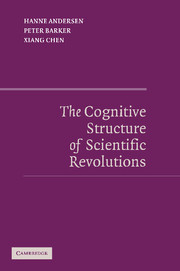Book contents
- Frontmatter
- Contents
- List of Figures
- Acknowledgments
- The Cognitive Structure of Scientific Revolutions
- 1 Revolutions in Science and Science Studies
- 2 Kuhn's Theory of Concepts
- 3 Representing Concepts by Means of Dynamic Frames
- 4 Scientific Change
- 5 Incommensurability
- 6 The Copernican Revolution
- 7 Realism, History, and Cognitive Studies of Science
- References
- Index
6 - The Copernican Revolution
Published online by Cambridge University Press: 18 July 2009
- Frontmatter
- Contents
- List of Figures
- Acknowledgments
- The Cognitive Structure of Scientific Revolutions
- 1 Revolutions in Science and Science Studies
- 2 Kuhn's Theory of Concepts
- 3 Representing Concepts by Means of Dynamic Frames
- 4 Scientific Change
- 5 Incommensurability
- 6 The Copernican Revolution
- 7 Realism, History, and Cognitive Studies of Science
- References
- Index
Summary
THE CONCEPTUAL STRUCTURE OF PTOLEMAIC ASTRONOMY
In astronomy before Kepler the path of a planet was not its orbit but the pattern of its motion seen by an observer on a stationary earth against the hypothetical sphere of the heavens. It was recognized in antiquity that this pattern was not a real motion, but a complex outcome of the observer's viewpoint and a variety of circular motions that acted together. The task of astronomy was to define this pattern – to specify the path of the planet in this original sense. The real motion of the planet – its track in what we would now call three-dimensional space – was unknown, and possibly irrelevant. All other considerations – the causes of celestial motion, the actual dimensions of the heavens – were the business of a separate science, cosmology. It was well known that the goal of astronomy could be achieved, that is, the path of a celestial object could be predicted, without making specific assumptions about its distance from the earth, once appropriate rates of rotation were introduced (Evans 1998; Pedersen 1993).
The basic data of astronomy from antiquity to the sixteenth century – the explananda or, if you prefer, the ‘phenomena’ that needed to be ‘saved’ – were recorded observations of planetary positions. Sixteenth-century astronomy texts devoted most of their attention to motion in longitude.
- Type
- Chapter
- Information
- The Cognitive Structure of Scientific Revolutions , pp. 130 - 163Publisher: Cambridge University PressPrint publication year: 2006

